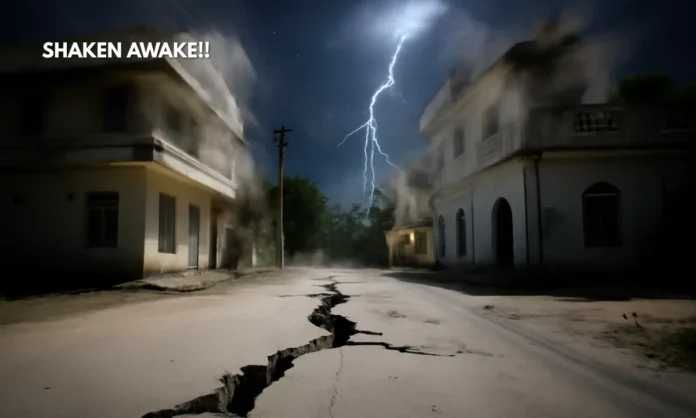Summary
- A mild Telangana earthquake of magnitude 3.1–3.8 was recorded early morning on August 14, 2025, with the epicentre near Vikarabad.
- Tremors were felt in multiple villages, prompting panic among residents, but no casualties or major damage were reported.
- The incident follows a series of minor quakes in recent months, raising concerns over increased seismic activity in the region.
Telangana Earthquake: Early Morning Shocks in Rural Telangana
The stillness of the early morning hours in Vikarabad district was abruptly broken when a Telangana earthquake rattled homes and startled residents awake. Recorded at approximately 03:56 am by the National Center for Seismology (NCS), the quake registered a magnitude of 3.1, although some local news outlets reported it as high as 3.8 on the Richter scale. The epicentre was located near Asifabad, and the tremors lasted for roughly three seconds, enough to cause anxiety in communities unaccustomed to such disturbances.
Villages including Rangapur, Basipalli, and Nyamatnagar reported noticeable shaking, with residents rushing outdoors in fear of potential aftershocks. Despite the sudden jolt, officials confirmed there were no reports of injuries or significant property loss, offering some relief to the shaken communities.
Breaking News
— Naseer Giyas (@NaseerGiyas) August 14, 2025
Vikarabad: Mild earthquake tremors were felt in Parigi mandal at around 4:00 AM, lasting for about three seconds in Basireddypalli, Rangapur, and Nyamatnagar villages.
Localised Impact and Unusual Weather Patterns
- Several areas in Telangana experienced unexpected winds following the tremors.
- Power supply interruptions were reported in select districts.
While the Telangana earthquake itself caused no structural damage, its aftermath saw an unusual weather twist. Regions such as Reenagar, Jagtial, Sircilla, and Peddapalli encountered brief but strong gusts of wind, leading to temporary disruptions in electricity supply. Local electricity boards worked quickly to restore service, minimising inconvenience to residents.
The dual occurrence of seismic activity and weather disturbance on the same day left experts intrigued, though no official link between the two events has been established. This has, however, intensified discussions on the unpredictability of natural phenomena in the state.
Patterns of Seismic Activity in the Region
- Minor quakes were reported in multiple Telangana districts earlier in 2025.
- Experts warn that these events highlight the need for earthquake preparedness.
The August 14 Telangana earthquake is not an isolated incident. Earlier in May 2025, minor quakes affected Nirmal, Nizamabad, unified Karimnagar, and unified Medak districts. One notable quake near Kumuram Bheem Asifabad measured 3.8 in magnitude and occurred at a shallow depth of 10 kilometres, a pattern similar to the latest event.
According to the Geological Survey of India, much of Telangana lies in a moderate seismic zone (Zone II), where earthquakes are infrequent but not impossible. The recent frequency of tremors has renewed calls for a comprehensive seismic risk assessment of the state’s rural and semi-urban belts.
Official Response and Public Communication
- State disaster management officials issued reassurance statements to prevent panic.
- The NCS released official quake details within hours of the event.
Following the Telangana earthquake, the state’s disaster response authorities quickly issued advisories confirming there was no immediate risk of aftershocks. The National Center for Seismology’s official record noted the time, coordinates, and magnitude of the quake, clarifying any discrepancies in early media reports.
In villages, local administration teams conducted door-to-door visits to check on vulnerable populations, including the elderly and those living in mud houses. These outreach efforts were crucial in ensuring accurate information reached residents, countering rumours and misinformation that tend to spread rapidly during natural events.
Expert Opinions and Safety Recommendations
- Preparedness is key, even for low-intensity seismic zones.
- Earthquake drills and awareness campaigns are recommended.
Seismologists emphasise that while the Telangana earthquake was of low magnitude, it serves as a timely reminder that no region is entirely immune to geological activity. Experts recommend that rural communities be educated on basic safety measures, such as moving to open spaces during tremors and keeping emergency kits ready.
Schools and public buildings, in particular, are advised to periodically conduct evacuation drills. These measures, though simple, can significantly reduce risks in the rare event of a stronger earthquake.
Looking Forward: Assessing Risks and Preparedness
- Increasing seismic events may require updated infrastructure guidelines.
- Collaboration between state agencies and national geological bodies is essential.
The recurrence of mild tremors across Telangana in recent months has sparked debate over whether current building codes adequately reflect the region’s emerging risk profile. Civil engineers argue that while the Telangana earthquake caused no damage this time, even minor quakes can weaken poorly constructed buildings over time.
Going forward, enhanced collaboration between the State Disaster Management Authority, the Geological Survey of India, and the National Center for Seismology could help create a more robust monitoring and response framework. This would include installing more seismographs in rural districts and improving early warning systems.
Closing Perspective
The early morning Telangana earthquake may not have left behind physical devastation, but it did highlight a vulnerability that often goes unnoticed. Rural communities, with their limited exposure to seismic events, are more susceptible to panic and misinformation. By strengthening preparedness measures, improving public awareness, and investing in monitoring infrastructure, Telangana can turn this minor quake into a catalyst for greater resilience.
While the tremors lasted only a few seconds, the conversations they have sparked about safety, readiness, and environmental unpredictability may last much longer. The August 14 incident is a small reminder that even in regions where the ground is usually still, it can sometimes shift without warning.


